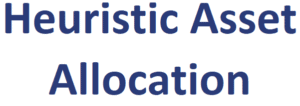Heuristic Asset Allocation Approaches
Heuristic asset allocation approaches are used by investors to construct portfolios. Unlike more sophisticated approaches such as traditional mean-variance optimization, they are not based on theoretical models and don’t require sophisticated mathematics. These approaches also don’t necessarily lead to an optimal asset allocation in the way that it is defined under traditional approaches.
On this page, we discuss five alternative asset allocation approaches:
- 120 minus your age
- 60/40 split
- Endowment model or Yale mode
- Risk parity
- 1/N rule
120 Minus Your Age
The first approach is very easy. This approach relates your age to your allocation to equities, so that 120 – age = % allocation to equities, and the remainder going into fixed income. That means a sixty year old person should have a 60% allocation to equities. A seventy year old person should have a 50% allocation to equities.
The 120 Minus Your Age is consistent with the idea that as the value of human capital declines as we age, our capacity to bear risk in the rest of the portfolio declines, suggesting that we move from equities into fixed income. This method is surprisingly consistent with the allocations that target date retirement funds use.
60/40-split
The 60/40-split one is even easier than the 120 Minus Your Age approach. You simply maintain your asset allocation at 60% stocks and 40% bonds. This is not nearly as off-the-wall as it sounds, as the global financial asset portfolio has historically been split approximately 60/40 between stocks and bonds.
Endowment Model or Yale Model
The Endowment Model or Yale Model allocates a larger amount to alternative investment asset classes (private equity, real estate, or natural resources) than is typically recommended by a strict MVO. Presumably these markets are less-than-perfectly informationally efficient, so investment managers with expertise in these markets can outperform expectations. Also, they are less liquid, and certain institutional investors are positioned to take on additional liquidity risk in return for a liquidity premium because of their longer time horizons.
Risk Parity
Thi idea with risk parity asset allocation is that diversification is achieved by ensuring that each asset class contributes the same amount to the total portfolio risk. This ensures that we are diversified across risk sources. The criticism of this approach is that it ignores expected returns and focuses only on risk. Moreover, it is quite sensitive to the construction of the opportunity set. A related approach is hierarchical risk parity.
1/N Rule
If we create an equally weighted portfolio in which we allocate the same percentage to each asset class, we have in effect weighted each class by 1/N, where N is the number of asset classes. With 5 asset classes, this approach suggests we invested 20% in each class. We then rebalance to equally weighted each quarter. There is some empirical evidence that this type of approach performs better than we would expect.
Summary
We discussed five simple alternative approaches that can be used to perform asset allocation.

